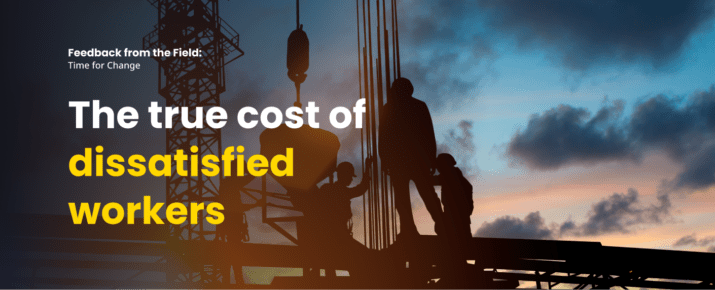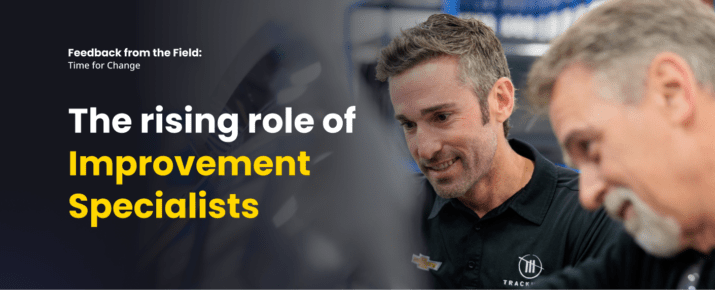Feedback from the Field: Insights from our global frontline worker survey on productivity, AI, and workforce challenges
Feedback From The Field | By | 22 Oct 2024 | 4 minute read

Our global pulse check on frontline opinions
Ever wanted to get into the minds of your frontline team? Well, we’re here to help, with some fresh new insights in the form of Feedback from the Field: Time for Change.
This report is our fourth annual edition of in-depth research into the state of the frontline. This year, we conducted one of the largest global studies on frontline workforce dynamics and surveyed over 10,000 workers and managers across Australia, the UK, the US, Germany, France, and Ireland.
With 2.7 billion deskless1 workers worldwide, organizations must tune in to the challenges they face, both for the frontline employees on the tools and their managers. The report highlights a global workforce grappling with inefficiencies, fractured relationships with management, an interesting perspective on AI and automation, outdated tools, and where HSQ roles are heading.
So what did we find? Here’s some of the highlights:
Dissatisfaction is draining productivity
An alarming 78% of workers told us they’re dissatisfied with some aspect of their job. When we look closer at their reasons, they cite slow responses to issues or risks (40%), unreasonable expectations (35%), and pressure to cut corners (32%) as the top factors contributing to dissatisfaction. It’s impacting morale, and hitting productivity hard.
The report found that workers lose about seven hours each month on average to unproductive downtime, mistakes, or absenteeism because of their frustrations. And it adds up. In total, this loss in productivity equates to $196 billion2 annually, a figure we’ve dubbed the “Dissatisfaction Dollar.”
For many workers, dissatisfaction directly impacts their performance. Of those we surveyed, 44% feel less motivated, 34% experience reduced productivity, and 31% consider quitting—which rises to 35% among Gen Z workers.
Is there an “Us versus Them” mentality between management and frontline employees?
A common theme has emerged from previous Feedback from the Field reports that an “us versus them” divide exists between frontline employees and management. To set the record straight, this year, we asked workers outright whether they experienced a divide. Just over half (52%) of all workers believe there is an “us versus them” mentality, a feeling which is more prevalent in management (55%) than frontline employees (50%).
Sam Byrnes, Chief Product Officer, says that this divide is damaging workplace culture and productivity.
“Frontline workers are telling us they feel unheard, over-stretched, and compromised. Leaders are doing a disservice by failing to address these challenges with their teams,” Byrnes said.
Pay, recognition, and communication are key to repairing relationships
For workers who believe the relationship with management can be improved, over half (55%) say better pay and benefits could help. This sentiment is particularly strong among frontline workers (61%) compared to managers (46%).
Aside from financial benefits, workers also say they value the importance of regular recognition for strong performance (47%), better communication (46%), and acknowledging and acting on feedback (40%) as ways to improve the relationship.

Outdated tools are slowing workers down
While there’s been widespread concern about the impact of new technologies like AI, only 34% of workers are unfazed by their potential impact. In fact, the real threat is that workers are far more frustrated with outdated tools and IT systems that limit their ability to do their jobs effectively.
A full 63% of workers told us they’re dissatisfied with their current tools, and 36% are just downright frustrated by outdated systems. 31% find that the tools they use are unfit for purpose. Not only are they frustrated, but it’s impacting their productivity, too. On average, workers lose six hours a month due to inefficient tools, and businesses wear the cost of this – adding up to USD $162 billion3 annually.
“Workers are only as effective as their tools,” Byrnes commented. “That’s why we’ve designed SafetyCulture to be a mobile-first platform that meets the needs of frontline teams.”
A looming brain drain and skills shortage
Adding to the pressure, there’s a growing concern that skills shortages will impact frontline industries for years to come. Nearly three in five (57%) workers believe that their industry will face a brain drain in the future. 71% say skills and labor shortages will present critical issues, but many believe their industry is already affected their industries, while others expect to feel the impacts of shortages within the next three years.
“Workers across the globe are experiencing a huge amount of change. Rising living costs, shrinking skills pipelines, and new technologies like AI, just to name a few, are demanding transformation. Even though this time is filled with uncertainty, it’s ripe with opportunity to build organizations that don’t just survive but thrive in the future.” says Byrnes.
As businesses navigate these challenges, one thing is clear: the cost of inaction is too high. By addressing dissatisfaction, improving communication, and investing in better tools, businesses can use this period of change as a driver of growth and success.
Health, safety, and quality leaders positioned to drive improvements
56% of Health, Safety, and Quality leaders told us that continuous improvement is discouraged in their organizations, compared with 38% of workers not in HSQ roles. They’re the ones driving change and getting pushback. At the same time, workers are calling for quicker action on reported issues. HSQ leaders are uniquely positioned to make improvements within their organization. That’s where the Improvement Specialist movement comes in.
Improvement Specialists, often frontline workers, identify opportunities for change, whether digitizing processes, closing communication gaps, or ensuring prompt action. They build strong relationships between frontline employees and management and create environments where knowledge-sharing is easy, feedback is addressed promptly, and tools are used effectively.
With 64% of HSQ leaders concerned about a future brain drain, Improvement Specialists help reduce this risk by fostering safer, more efficient workplaces, ultimately leaving their industries stronger.
Practical solutions to global issues
Our Feedback from the Field: Time for Change report explores how organizations can make incremental changes to leave our industries more productive than they were before. Read the full report to learn more.
1 Emergence (2020). The State of Technology for the Deskless Workforce.
2 The cost of dissatisfaction to business
YouGov calculated this figure based on the average local weekly wage, the estimated average hours lost to the effects of dissatisfaction as reported by survey respondents, and the estimated number of workers in frontline industries.
Local wage estimates were sourced from national statistical agencies, and the number of worker estimates were sourced from YouGov Profiles.
3 The cost of ineffective tools and IT systems to business
This figure was calculated by YouGov based on the average local weekly wage, estimated average hours lost to ineffective tools and IT systems as reported by survey respondents, and the estimated number of workers in frontline industries.
Local wage estimates were sourced from national statistical agencies and the number of workers estimates were sourced from YouGov Profiles.
Important Notice
The information contained in this article is general in nature and you should consider whether the information is appropriate to your specific needs. Legal and other matters referred to in this article are based on our interpretation of laws existing at the time and should not be relied on in place of professional advice. We are not responsible for the content of any site owned by a third party that may be linked to this article. SafetyCulture disclaims all liability (except for any liability which by law cannot be excluded) for any error, inaccuracy, or omission from the information contained in this article, any site linked to this article, and any loss or damage suffered by any person directly or indirectly through relying on this information.





